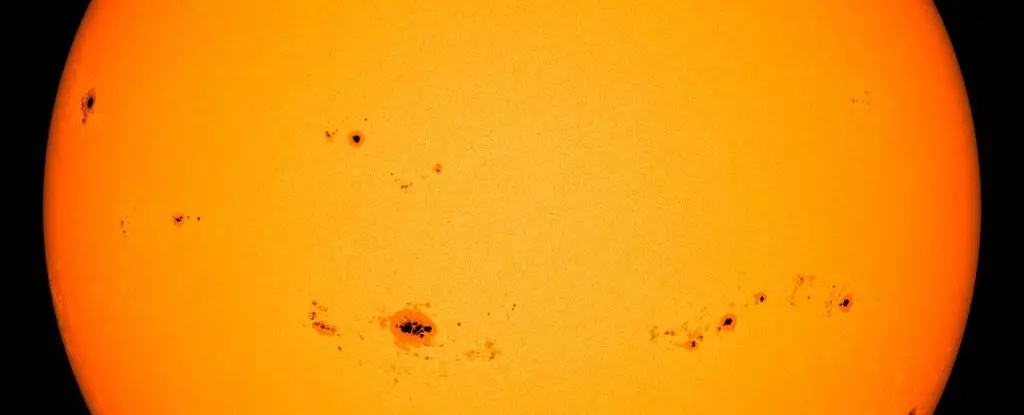In an exhilarating announcement that has captivated both scientists and space enthusiasts alike, NASA, in conjunction with the National Oceanic and Atmospheric Administration (NOAA) and the Solar Cycle Prediction Panel, has confirmed that the Sun has officially entered its solar maximum phase. This peak period in the Sun’s 11-year activity cycle is characterized by an increase in solar phenomena, such as sunspots, solar flares, and coronal mass ejections (CMEs). This means Earth’s nearest star is in a volatile state, setting the stage for unpredictable space weather events in the coming months.
Despite this surge in activity, forecasts regarding peak solar activity remain largely speculative. Meteorologist Elsayed Talaat from NOAA emphasizes that while we now recognize we are in the solar maximum, the exact moment when solar activity will reach its zenith is a matter of ongoing study. This indicates the complexities surrounding solar dynamics and affirms that the study of our solar neighbor is both uncertain and fascinating.
Understanding solar cycles is like navigating a cosmic puzzle. Each cycle lasts about 11 years but varies in intensity and duration. The Sun undergoes a series of magnetic shifts, which ultimately governs the behaviors we observe on its surface. Yet, despite centuries of solar observations, the underlying mechanisms generating these cycles remain elusive. As Michael Wheatland, a solar astrophysicist at the University of Sydney, aptly notes, the interplay between solar magnetic fields and sunspot dynamics poses significant challenges to astrophysicists.
Sunspots, appearing as temporary dark spots on the solar surface, occur where magnetic forces are particularly strong and tangled. They represent the Sun at its most tumultuous, where interconnected magnetic fields can suddenly snap, resulting in energetic solar flares that emit vast quantities of radiation into space. In contrast, during solar minimum, these areas are virtually absent, resulting in a calmer solar atmosphere.
What does this mean for us on Earth? The ramifications of increased solar activity can be both breathtaking and concerning. Notably, powerful solar flares can lead to radio blackouts that disrupt our communication systems. Furthermore, when coronal mass ejections collide with Earth’s magnetic field, geomagnetic storms can occur. These storms pose potential risks, such as damage to electrical grids and disruption of satellite operations and navigation systems.
However, these solar outbursts, while disruptive, also result in breathtaking natural phenomena like auroras. The brilliance of the Northern and Southern Lights is a direct consequence of solar particles interacting with Earth’s atmosphere. This year has witnessed increased aurora activity, gifting many regions with stunning views of these light displays.
So far, the current solar cycle has shown to be stronger than initial forecasts anticipated, but it remains important to contextualize this increase. While the activity we’re witnessing is notable, it does not yet approach the intensity of some historical solar cycles. For instance, an X9.0 class flare erupted on October 4, 2022, ranking among the top 20 most significant solar flares ever recorded. Even so, historians of solar activity note that more extreme events have occurred, suggesting that while we’re experiencing lively space weather, it is still within the bounds of normalcy.
Interestingly, despite inaccurate predictions by some models, a subset of scientists had accurately forecasted the cycle’s strong performance. This divergence of predictions could lead to important advancements in our understanding of solar dynamics. As we refine our models, there is hope that we can better anticipate future behaviors of our Sun.
As we brace ourselves for intensified solar activity, one significant takeaway is the importance of monitoring the Sun—both for protecting our technological systems and for continuing to unravel the mysteries that govern our solar system. The current solar maximum invites us not only to gaze in awe at the power of our star but also to engage in the scientific endeavors necessary to understand it better.
While the future remains uncertain, the thrill of discovery and the ongoing quest to unlock the secrets of our Sun promises a thrilling ride. Armed with both anticipation and caution, we can better navigate the beautiful chaos that the solar cycles bring, while appreciating the vital role the Sun plays in sustaining life on Earth. As we stand on this precipice of knowledge, the dance of solar activity continues, offering both challenges and extraordinary beauty.


Leave a Reply